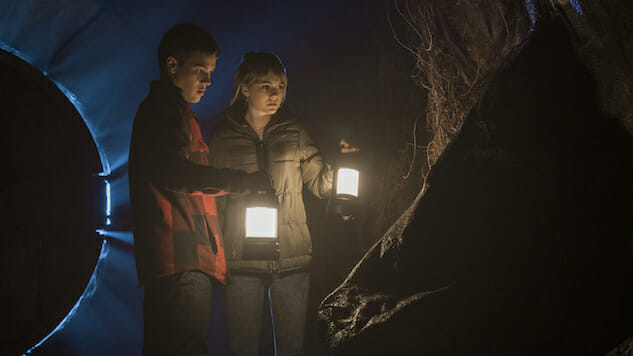Locke & Key Keeps Its Magical Potential Behind a Dull Deadbolt
Photo Courtesy of Netflix
Locke & Key, the long-coming and much-iterated adaptation of Joe Hill and Gabriel Rodriguez’s comic series, has finally landed at Netflix from showrunners Carlton Cuse and Meredith Averill. Though the punnily-titled franchise finally got past the pilot stage after an aborted attempt back in 2011, its unique take on magic-empowered youths (with abilities linked to talisman-like keys instead of being inherent to the characters, a la Umbrella Academy) isn’t anywhere close to the shiniest key on the streaming ring.
High schoolers Tyler (Connor Jessup) and Kinsey (Emilia Jones) move into their ancestral family home with their mom (Darby Stanchfield) and kid brother Bode (Jackson Robert Scott) after the murder of their dad (Bill Heck). The Locke family has a love of puns (they named the old Haunting of Hill House-looking mansion Key House) and a lot of baggage. They’re trying to move on, ostensibly by fixing up the old place and getting it ready to sell. Really, they’re pushing through the tragedy by delving deeper into their father’s memory and legacy, embracing familial closeness. As hidden keys around the house audibly beckon to the children (whispering like Sauron’s ring) and begin to reveal themselves and their powers, the history of the Locke family becomes a lot more fun than an old photo album.
One key allows you to go anywhere, as long as you’ve seen the door you want to exit through; one allows you to go inside your own head, where emotions and memories physically manifest. We’re immediately thrown into what feels like the middle section of an ‘00s magical YA series where the heroes need to therapeutically face their CG demons. That said, the physicality of mourning, with the family navigating the layers of their past through these various mystical gates (their thresholds and the wondrous, sometimes dangerous, worlds lying beyond stand in for psychological breakthroughs) is the most effective storytelling tactic in this YA-toned horror-esque tale. The town and their father have many secrets that reveal themselves over the course of the first season’s ten episodes, but when the Lockes leave the house, the show leaves behind its only interesting component.
The acting is stilted; Jessup (whose soft Josh Hartnett-esque performance is just the first indication of the show’s mid-’00s sensibilities), Heck, and Griffin Gluck show flashes of charm, but the dialogue is often on the Riverdale side of campy without the Riverdale kind of crazy. The non-family conversations are by far the weakest part of the show. They’re either too try-hard cheeky (if a teen approaches you with friends he calls “droogs,” turn and run the other direction) or 0-to-60 intense. The supporting high schoolers and townsfolk are resolutely terrible (Coby Bird, a rare case of an austitic actor portraying an autistic character, is a lonely bright spot), which makes almost everything outside of Key House awful to get through, especially after it shows off some of its tricks. Why waste time with bad, magic-free romantic subplots when there’s a key that turns you into a ghost?
As soon as it fleshes out its magic in the middle of the season, Locke & Key pulls back in a major way. It gets repetitive and silly, insecure about its audience’s commitment to its characters, miring the brisk pace of its introduction in high school histrionics and tangential mysteries. That’s too bad, because there are a lot of fun horror elements that aren’t particularly sleep-ruining, but still might give you a reason to rethink walking around the house in the middle of the night.
Case in point, Laysla De Oliveira plays the engrossing (possibly demonic) villain Dodge, a slinking supernatural woman rising from the darkest depths of the house to pursue its hidden treasures—and she’s just the catalyst for the rest of the show’s fun eeriness. Uncanny reflections, intricate keys, hidden voices, and a Heelys remix of The Shining’s famous Big Wheel tracking shot all contribute early on to an aesthetic and tone that prizes youth-accessible, unsettling creepiness over jump scares. More Coraline than Conjuring, there are still plenty of fancy camera moves (long, variously tilting shots through the home’s lovely halls) to make the setting unsettling.